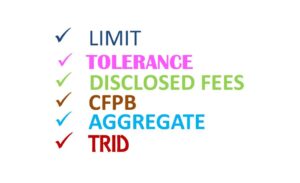 The updates to the TRID rules, recently released by CFPB, include a clarification of the tolerance limits for the fees for the services for which a consumer may shop when a service provider list is not provided. These are the fees disclosed to a borrower in Section C of the Loan Estimate.
The updates to the TRID rules, recently released by CFPB, include a clarification of the tolerance limits for the fees for the services for which a consumer may shop when a service provider list is not provided. These are the fees disclosed to a borrower in Section C of the Loan Estimate.
TRID requires a lender to disclose all fees and charges based on the best information reasonably available at the time of the disclosure. This is help keep lenders from “low balling” their estimates for all charges, including those for which the rule does not apply a tolerance limit.
The update clarifies that when a lender does not provide the consumer with a list of available service providers for the services disclosed in Section C (those for which the consumer may shop), the lender will be held to a 10% aggregate tolerance limit regardless of the service provider chosen by the borrower.
Otherwise, when the provider list is given and the borrower chooses a provider other than one on that list, the tolerance limit is waived.

It behooves lenders to provide an accurate good faith estimate of these charges and to provide a list of at least one entity that will provide the listed services, for the aggregate of the fees disclosed in Section C.
There is a little caveat. The 10% aggregate tolerance is based on the fees disclosed in Section C, plus the recording fees.
However, to get to the tolerance limit all the fees disclosed on the initial Loan Estimate must also be charged at closing, and appear in Section C of the final CD. A lender may charge additional fees that are not disclosed but must charge any that are disclosed.
Example: Let’s say the total amount of all separate fees disclosed in Section C of the initial LE is $1,500. That would allow a tolerance at the closing of $150 when no provider list is provided, or a list is provided and the borrower selects a provider from the list. In this case total Section C fees could be up to $1,650 ($1,500 + $150 = $1,650).
At closing, the total charges for Section C aggregate $1600. Accordingly, it would appear the loan is within tolerance (given the recoding fees are the same on both disclosures).
But wait…if a $300 title search fee was disclosed on the initial LE and included in the $1,500 total, but that same fee was not charged and reflected on the final CD, the loan is out of tolerance.
How you say? By disclosing, but not charging, the search fee the initial base amount for determining the 10% tolerance from the initial LE is reduced by the $300.
Therefore, the total Section C fees disclosed on the initial LE are now $1,200 ($1,500 – $300), reducing the tolerance to $120 (10% of $1,200). This reduces the overall allowable down from $1,650 to $1,320.
In this case, the lender owes the borrower a cure of $280.00 ($1,600 – $1,320 = $280) because the $300 search fee disclosed on the initial LE was not charged to the borrower on the final CD.
The “good faith” rule applies not only to the amount of the fee for each service but also to what services the consumer may be charged.
For this reason, it is important to provide the consumer with a list of your potential service providers for the services disclosed in Section C and to know and accurately disclose the list of services they will provide and the fees for each service.
As an alternative, a lender may disclose a single, all-in fee for all title/closing services disclosed in Section C to cover what will be charged by the closing entities disclosed on their service provider list.
In such cases the ‘flat’ amount disclosed, plus the recording fees will be held to the 10% tolerance limit when one of those on the provider list is used by the borrower.
If you’re interested, you can review all the recent TRID updates at TRID 2.0 Updates. Have fun.
